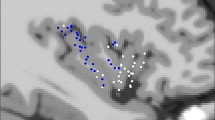Summary
Auditory ERP (AERP) studies have been performed in 56 patients with central nervous system disturbances. Forty seven patients(90.5%), had AERP component abnormalities concerning mainly P300 topography alterations and secondarily P300 latency prolongation. It is concluded that P300 is a very useful tool in clinical neurology and that P300 topography or latency alterations are not specific of any cerebral disturbance but can be found in any disease whenever cognitive functions are impaired.
Similar content being viewed by others
References
Ball, S.S., Marsh, J.T., Schubarth, G., Brown, W.S. and Strandburg, R. Longitudinal P300 latency changes in Alzheimer's disease. J. Gerontol, 1989; 44; m 195–200.
Burgt, M. v.d. and Hamburger H.L. The normal values of ERP components in topographic mapping. Brain Topography, 1988; 1: 145.
Burgt, M. v.d. and Hamburger, H.L. Classical method versus global field power in the determination of the latency of evoked potentials. Brain Topography, 1988; 1: 145–146.
Burgt, M. v.d. and Hamburger H.L. Classical method versus global field power in the determination of the latency of evoked potentials, Brain Topography, 1990.
Daruna, J.H., Nelson, A.V. and Green, J.B. Unilateral temporal lobe lesions alter P300 scalp topography. Int. J. Neurosci., 1989; 46: 243–247.
Drake, M.E. Jr., Pakalnis, A. and Padamadan, H. Long-latency auditory event related potentials in migraine headache, 1989; 29: 239–241.
Duffy, F.H., Denckla, M.B., Bartels, P.H., Sandini, G. and Keissling, L.S. Dyslexia: Automated diagnosis by computerized classification of brain electrical activity. Ann.Neurol., 1980; 7: 421–428.
Harter, M.R., Anllo-Vento, L. and Wood, F.B. Event-related potentials, spatial orienting, and reading disabilities. Psychophysiology, 1989; 26; 404–421.
Hynd, G.W. and Semrud-Clikeman, M. Dyslexia and neurodevelopmental pathology: relationships to cognition, intelligence, and reading skill acquisition. J. Learn Disabil., 1989 Apr; 22(4); 204–216, 220.
Johnson, R. Jr. Scalp-recorded P300 activity in patients following unilateral temporal lobectomy. Brain: 1988; 111; 1517–1529.
Knight, R.T., Scabini, D., Woods, D.L. and Clayworth, C.C. Contributions of temporal-parietal junction to the human auditory P3. Brain Res: 1989; 13; 502(1); 109–116.
Lehmann, D. and Skrandies, W. Reference-free identification of components of checkerboard evoked multichannel potential fields. Electroenceph. Clin. Neurophysiol., 1980, 48: 609–21.
McCarthy, G., Wood, C.C., Williamson, P.D., Spencer, D.D. Task-dependent field potentials in human hippocampal formation. J. Neurosci., 1989 Dec; 9(12); 4253–68.
Patterson, J.V. and Michalewski, H.J. Starr A. Latency variability of the components of auditory event-related potentials to infrequent stimuli in aging, Alzheimer-type dementia, and depression. Electroenceph. Clin. Neurophysiol., 1988; 71; 450–460.
Polich J. P300 and Alzheimer's disease Biomed. Pharmacother., 1989; 43; 493–499
Puce, A. and Bladin, P.F. Scalp and intracerebral P300 in surgery for temporal lobe epilepsy. Clin. Exp. Neurol., 1987; 24; 85–89.
Puce, A., Donnan, G.A., Bladin, P.F. Comparative effects of age on limbic and scalp P3. Electroenceph. Clin. Neurophysiol: 1989, 74, 385–393.
Rodin, E., Khabbazeh, Z., Twitty, G. and Schmaltz S. Cognitive evoked potentials in epilepsy patients. Clin Electroencephalogr: 1989; 20; 176–182.
Smith, M.E. and Halgren, E. Dissociation of recognition memory components following temporal lobe lesions. J. Exp. Psychol. [Learn Mem Cogn]: 1989; 15; 50–60.
Velasco, M., Velasco, F. and Velasco, A.L. Intracranial studies on potential generators of some vertex auditory evoked potentials in man. Stereotact. Funct. Neurosurg: 1989; 53; 49–73.
Author information
Authors and Affiliations
Rights and permissions
About this article
Cite this article
Hamburger, H.L., Triantafyllou, N.I. Clinical applications of auditory event related potentials in neurology. Brain Topogr 3, 49–52 (1990). https://doi.org/10.1007/BF01128861
Accepted:
Issue Date:
DOI: https://doi.org/10.1007/BF01128861




